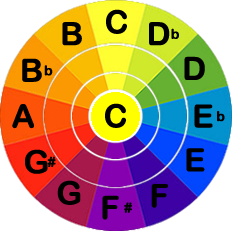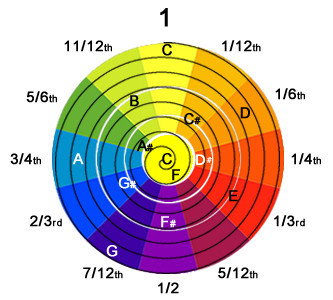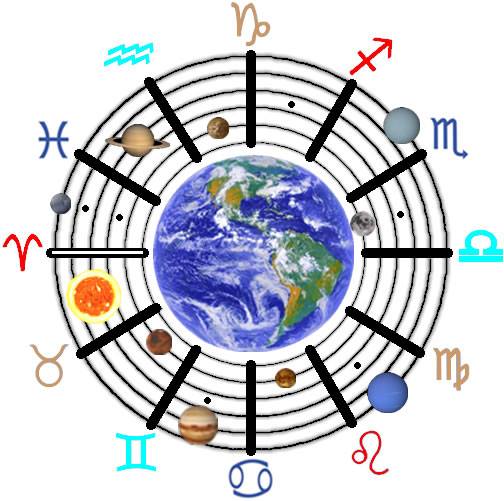“There is geometry in the humming of the strings, there is music in the spacing of the spheres.”
~Pythagoras
What is Cyclical Dynamics?
Simply put, Cyclical Dynamics is the dynamics of any cycle or cyclic activity. We are accustomed to the diurnal cycle of the Earth spinning on its axis every 24 hours, giving us dawn and dusk, midday and midnight. We’re also quite familiar with the annual cycle of the Earth’s orbit around the Sun, giving us the spring and fall equinoxes and the summer and winter solstices. We can also observe the lunar cycle of the Moon’s orbit around the Earth, giving us the New and Full Moon and the quarter moons. Each planet has its cycle on its own timescale, but the dynamics of the cycle remain consistent.

We’re familiar with the shape of the zodiac, and though the planets continue to move, we can easily observe the cyclical nature of their dance. This ancient circle is divided equally into twelve signs, and when a planet completes a cycle, it begins a new one. Each of the twelve points holds tension that can be resolved when the cycle is completed. Each point on the wheel has an angular relationship to the other points, and some angles hold more tension than others. Though we may understand that planets interact this way, other cyclical dynamic systems are not so apparent.
The Octave
At the heart of music theory is a mysterious structure called the “octave.” Though there are countless pitches, there are only twelve pitch classes that continue to repeat in higher and lower octaves. We can picture an octave as a circle divided by twelve points, like an analog clock or the zodiac. Classically trained musicians are accustomed to viewing the circle of 5ths in a cyclical format. But they may not be as familiar with this more basic model called a “chromatic wheel.” We can learn a great deal about the circle of 5ths and 4ths from the chromatic wheel, but traditional music theory courses rarely utilize this model.

With a cyclical format for Music Theory, we can observe the same dynamic points in musical intervals that we see in astrological aspects. Let’s look at everyone’s favorite transit in the Sun’s cycle, our birthday. On our birthday, the Sun is in roughly the same degree as when we were born. Each month the Sun moves about 30 degrees, so all minor and major aspects between the Sun and our Natal Sun are in approximately one-month intervals. Therefore, about two months after our birthday is our Sun sextile Natal Sun, one month later is our Sun square Natal Sun, and one month after that is Sun trine Natal Sun. Six months after our birthdays is our Sun opposite Natal Sun, and the pattern repeats in reverse order as the Sun moves onto our next birthday.

The Key
If we consider our Natal Sun position to be the key of a song, then the Sun moves through each interval as it moves around the zodiac. The Sun sextile Natal Sun (60°) is a Major 2nd interval, Sun square Natal Sun (90°) is a minor 3rd, Sun trine Natal Sun (120°) is a Major 3rd, and Sun oppose Natal Sun (180°) is a flat (or diminished) 5th interval. The next trine is minor 6th, the next square is a Major 6th, and the next sextile is a dominant 7th. In astrology, the square transit holds a lot of dissonant tension, and the trine is an easy and pleasant respite. In music theory, the minor 3rd has the same dissonant tension that we can feel in a square. And in the Major 3rd, we can hear that tension resolve harmoniously.

What we call an “opposition” in astrology is a “diminished 5th” in music theory. This interval represents the point of greatest instability because it splits the octave into perfect halves. In most cases, without any training at all, the ear can quickly determine which note is the “One” or “Key.” However, when the intervals are all equally spaced, the ear experiences a brief state of confusion. I say brief because we often refer to these intervals as “passing tones.” They may be tense but usually resolve quickly in the next chord. At the culmination of the cycle we end up where we began, the conjunction representing the “one” or “key” of our song.
The Perfect 5th
The Major transits in astrology leave out some of the essential intervals in music theory. The quincunx is an odd aspect in that it represents the only points of unequal division in the cycle. Any cycle of twelve can be divided equally by 1, 2, 3, 4, and 6, but not by 5 or 7. The zodiac can be viewed as a series of 12 semi-sextiles, 6 sextiles, 4 squares, 3 trines, or 2 oppositions, all of which divide the cycle equally. The math is simple: 1/12, 1/6, 1/4, 1/3, and 1/2. But 5/12 and 7/12 do not divide the cycle equally. In music theory, 5/12 is called a “sus 4th” or just “4th.” The 7/12 position is the most significant musical interval, and we call it the “perfect 5th.”
We have a circle of 5ths because it takes several cycles to resolve these intervals back to the original position: the one. In contrast, the other intervals can all be resolved in a single cycle. If we move 7 of 12 steps around the zodiac, we land on the second quincunx. And if we move another 7 steps, we land on the first sextile in the next cycle. Another 7 steps and we land on the second square in the same cycle, and in 7 more steps, we land on the first trine in another cycle. It takes 12 steps to return to the original position, at

which point we will have landed on each minor and major aspect once. In music theory, the circle of 4ths is the circle of 5ths in reverse order.
Dancing with the Stars
There’s so much more to cover in future posts. This is just a brief introduction to a theory that combines two rich tapestries. More important than the technical and practical sides of Cyclical Dynamics is the language that it provides us. There is a great deal of wisdom in the language of music accumulated throughout our evolution. It may be a metaphor to suggest that life is like a song, and we can derive all sorts of pleasure in our musings. However, my mission is to show that life is not like a song; life is a song. The entire universe is just one big song: Uni-Verse. We have but one choice in life, to dance with or against the stars.
Click Here to learn more about Cyclical Dynamics!
Listen to the Music of the Spheres

